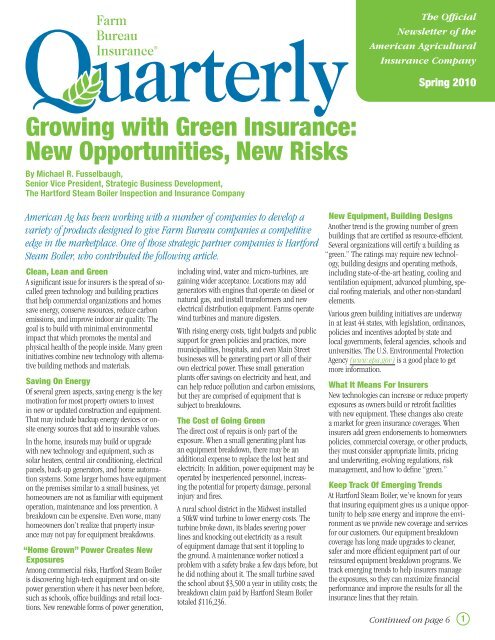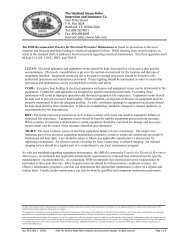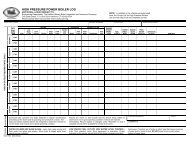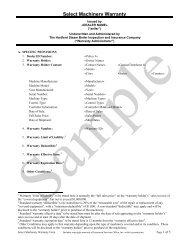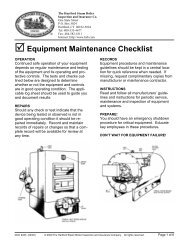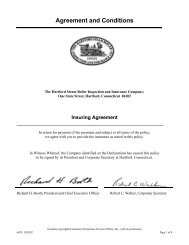New Opportunities, New Risks - Hartford Steam Boiler
New Opportunities, New Risks - Hartford Steam Boiler
New Opportunities, New Risks - Hartford Steam Boiler
Create successful ePaper yourself
Turn your PDF publications into a flip-book with our unique Google optimized e-Paper software.
The Official<br />
<strong>New</strong>sletter of the<br />
American Agricultural<br />
Insurance Company<br />
Spring 2010<br />
Growing with Green Insurance:<br />
<strong>New</strong> <strong>Opportunities</strong>, <strong>New</strong> <strong>Risks</strong><br />
By Michael R. Fusselbaugh,<br />
Senior Vice President, Strategic Business Development,<br />
The <strong>Hartford</strong> <strong>Steam</strong> <strong>Boiler</strong> Inspection and Insurance Company<br />
American Ag has been working with a number of companies to develop a<br />
variety of products designed to give Farm Bureau companies a competitive<br />
edge in the marketplace. One of those strategic partner companies is <strong>Hartford</strong><br />
<strong>Steam</strong> <strong>Boiler</strong>, who contributed the following article.<br />
Clean, Lean and Green<br />
A significant issue for insurers is the spread of socalled<br />
green technology and building practices<br />
that help commercial organizations and homes<br />
save energy, conserve resources, reduce carbon<br />
emissions, and improve indoor air quality. The<br />
goal is to build with minimal environmental<br />
impact that which promotes the mental and<br />
physical health of the people inside. Many green<br />
initiatives combine new technology with alternative<br />
building methods and materials.<br />
Saving On Energy<br />
Of several green aspects, saving energy is the key<br />
motivation for most property owners to invest<br />
in new or updated construction and equipment.<br />
That may include backup energy devices or onsite<br />
energy sources that add to insurable values.<br />
In the home, insureds may build or upgrade<br />
with new technology and equipment, such as<br />
solar heaters, central air conditioning, electrical<br />
panels, back-up generators, and home automation<br />
systems. Some larger homes have equipment<br />
on the premises similar to a small business, yet<br />
homeowners are not as familiar with equipment<br />
operation, maintenance and loss prevention. A<br />
breakdown can be expensive. Even worse, many<br />
homeowners don’t realize that property insurance<br />
may not pay for equipment breakdowns.<br />
“Home Grown” Power Creates <strong>New</strong><br />
Exposures<br />
Among commercial risks, <strong>Hartford</strong> <strong>Steam</strong> <strong>Boiler</strong><br />
is discovering high-tech equipment and on-site<br />
power generation where it has never been before,<br />
such as schools, office buildings and retail locations.<br />
<strong>New</strong> renewable forms of power generation,<br />
including wind, water and micro-turbines, are<br />
gaining wider acceptance. Locations may add<br />
generators with engines that operate on diesel or<br />
natural gas, and install transformers and new<br />
electrical distribution equipment. Farms operate<br />
wind turbines and manure digesters.<br />
With rising energy costs, tight budgets and public<br />
support for green policies and practices, more<br />
municipalities, hospitals, and even Main Street<br />
businesses will be generating part or all of their<br />
own electrical power. These small generation<br />
plants offer savings on electricity and heat, and<br />
can help reduce pollution and carbon emissions,<br />
but they are comprised of equipment that is<br />
subject to breakdowns.<br />
The Cost of Going Green<br />
The direct cost of repairs is only part of the<br />
exposure. When a small generating plant has<br />
an equipment breakdown, there may be an<br />
additional expense to replace the lost heat and<br />
electricity. In addition, power equipment may be<br />
operated by inexperienced personnel, increasing<br />
the potential for property damage, personal<br />
injury and fires.<br />
A rural school district in the Midwest installed<br />
a 50kW wind turbine to lower energy costs. The<br />
turbine broke down, its blades severing power<br />
lines and knocking out electricity as a result<br />
of equipment damage that sent it toppling to<br />
the ground. A maintenance worker noticed a<br />
problem with a safety brake a few days before, but<br />
he did nothing about it. The small turbine saved<br />
the school about $3,500 a year in utility costs; the<br />
breakdown claim paid by <strong>Hartford</strong> <strong>Steam</strong> <strong>Boiler</strong><br />
totaled $116,236.<br />
<strong>New</strong> Equipment, Building Designs<br />
Another trend is the growing number of green<br />
buildings that are certified as resource-efficient.<br />
Several organizations will certify a building as<br />
“green.” The ratings may require new technology,<br />
building designs and operating methods,<br />
including state-of-the-art heating, cooling and<br />
ventilation equipment, advanced plumbing, special<br />
roofing materials, and other non-standard<br />
elements.<br />
Various green building initiatives are underway<br />
in at least 44 states, with legislation, ordinances,<br />
policies and incentives adopted by state and<br />
local governments, federal agencies, schools and<br />
universities. The U.S. Environmental Protection<br />
Agency (www.epa.gov) is a good place to get<br />
more information.<br />
What It Means For Insurers<br />
<strong>New</strong> technologies can increase or reduce property<br />
exposures as owners build or retrofit facilities<br />
with new equipment. These changes also create<br />
a market for green insurance coverages. When<br />
insurers add green endorsements to homeowners<br />
policies, commercial coverage, or other products,<br />
they must consider appropriate limits, pricing<br />
and underwriting, evolving regulations, risk<br />
management, and how to define “green.”<br />
Keep Track Of Emerging Trends<br />
At <strong>Hartford</strong> <strong>Steam</strong> <strong>Boiler</strong>, we’ve known for years<br />
that insuring equipment gives us a unique opportunity<br />
to help save energy and improve the environment<br />
as we provide new coverage and services<br />
for our customers. Our equipment breakdown<br />
coverage has long made upgrades to cleaner,<br />
safer and more efficient equipment part of our<br />
reinsured equipment breakdown programs. We<br />
track emerging trends to help insurers manage<br />
the exposures, so they can maximize financial<br />
performance and improve the results for all the<br />
insurance lines that they retain.<br />
Continued on page 6<br />
1
A Word from Janet<br />
By Janet Katz<br />
Executive Vice President & Chief Executive Officer<br />
“Cedants Seek Long-Term Re Partnerships”<br />
-National Underwriter Property & Casualty,<br />
January 18/25, 2010<br />
This headline from National Underwriter is referring to<br />
the results of the 2009 Flashpohler Cedant Survey for<br />
non-life, North American ceding companies. This survey<br />
began in 1993 and has been repeated every two years<br />
since then. The 2009 survey had 696 cedant respondents<br />
across North America. Stock companies represented<br />
48% of respondents, mutual companies 31%<br />
and private/family owned businesses an additional 12%.<br />
Respondents were fairly evenly split among company<br />
size, with roughly 30% having gross premium volume<br />
below $100M, 40% between $100M and $1bn, and<br />
30% excess of $1bn.<br />
While American Ag is not one of the reinsurers included<br />
in the survey, the results are incredibly important and<br />
relevant to us and our clients. We are again very encouraged<br />
by the results, and feel we stack up very well to the<br />
issues and items identified as important to clients. The<br />
most important thing is that ceding companies continue<br />
to report the importance of long term relationships, and<br />
how critical it is to have trust and understanding between<br />
ceding companies and reinsurers. This is consistent with<br />
our business philosophy and reinforces that reinsurance<br />
is not just a commodity. Many of us have wondered<br />
lately if insurance and reinsurance are becoming too<br />
commoditized, and if relationships, whether it be agent<br />
contact with an insured or reinsurer contact with an<br />
insurance company, are still important. These survey<br />
results continue to support the fact that relationships still<br />
matter, and are still the driving force that determines the<br />
level of satisfaction a re/insurance customer has with<br />
their company.<br />
Respondents rated the following factors in order of<br />
importance in evaluating and selecting a reinsurer:<br />
Financial Security<br />
• Highly rated by objective rating agencies<br />
Underwriting Capabilities<br />
• Underwriters who are easily accessible; underwriters<br />
you respect and trust<br />
• Consistency in underwriting decisions<br />
• Underwriting philosophy compatible with the ceding<br />
company’s<br />
Strong Client Orientation<br />
• Understands the cedant’s business<br />
• Provides value through regular contact<br />
• Genuinely cares about a long-standing business<br />
relationship<br />
• Is easy to work with; open and transparent<br />
Financial Value<br />
• Differentiates clients based on client’s own reinsurance<br />
experience<br />
• Offers reinsurance cover and services which add value<br />
Timely Service<br />
• Timely quotes, returns calls promptly, timely handling<br />
of all documents<br />
Valuable Expertise and Market Knowledge<br />
• Staff with strong technical expertise to understand<br />
your business<br />
• Innovative and creative<br />
• Tailor made reinsurance solutions<br />
Strong Claims Handling Ability<br />
• Claims expertise<br />
• Pay claims in a timely manner<br />
• Reasonable and collaborative approach to paying<br />
claims<br />
• Competent support in claims handling<br />
Profitable Value-Added Services<br />
• Claims, Underwriting, and Actuarial services and<br />
consulting<br />
• Non-risk transfer services<br />
The survey results also included open comments made<br />
by survey participants. The first one on the list was:<br />
“We do business with people that we know, like and<br />
trust, in order to build long term relationships that<br />
are mutually beneficial”<br />
As both a buyer and provider of reinsurance, American<br />
Ag couldn’t agree more!<br />
2
May 31 Sees Several Key<br />
Retirements at AAIC<br />
When the morning of June 1 rolls around there<br />
will be some familiar faces missing at American<br />
Ag. Several long-time employees have opted to<br />
make May 31 their retirement date. We could<br />
probably publish an entire book if we were to<br />
give an in-depth summary of their entire careers,<br />
Farm Bureau and otherwise. We regret we<br />
have only enough space to provide these<br />
short summaries.<br />
Gary Brinkley started with<br />
North Carolina Farm Bureau<br />
in 1967 in the Claims department,<br />
and in 1981 he took<br />
over their Crop and Administrative<br />
Services. Gary came<br />
to American Ag on October 1,<br />
1984 to take care of the Crop<br />
Insurance due to Pat Marshall leaving to go into<br />
the roofing business (Pat did eventually return<br />
to AAIC). In 1986 Gary became Claims manager<br />
at AAIC. In 1998 he became head of Insurance<br />
Operations and in 1999 he became Senior Vice<br />
President, Administration and Assistant to the<br />
General Manager.<br />
Gary has contributed in so many ways to American<br />
Ag’s success over the years. His ideas and<br />
leadership will truly be missed. Please join us in<br />
wishing Gary, his wife Nancy and his family all<br />
the best in his retirement. His seven grandsons<br />
will keep him very busy!<br />
C. David Mayfield, American<br />
Ag’s Corporate Secretary<br />
and Acting General Counsel,<br />
will retire from the American<br />
Farm Bureau Federation after<br />
39 years of employment. Dave<br />
began his career with AFBF<br />
on May 1, 1971, following his<br />
graduation from the University of Nebraska College<br />
of Law in 1970 and a nine month internship<br />
at the Illinois Legislative Reference Bureau as a<br />
bi-partisan bill drafter. He has served in the AFBF<br />
legal department under five AFBF presidents:<br />
Bill Kuhfuss, Allen Grant, Robert Delano, Dean<br />
Kleckner, and Bob Stallman.<br />
Dave has served as Assistant Legal Counsel, Associate<br />
General Counsel, Deputy General Counsel,<br />
and Acting General Counsel, is the second-longest<br />
serving officer in the history of AFBF and affiliated<br />
companies, and served for 29 of his 39 years<br />
as Assistant Secretary (1982-1984), Secretary<br />
(1985-1999), and Corporate Secretary (2000-<br />
2010).<br />
Dave has been extraordinarily active on many<br />
important legal issues, a list much too long to<br />
mention here. He is known as the AFBF historian,<br />
guided AFBF in their organization and<br />
governance as well as AAIC’s board and annual<br />
meetings, and recorded the actions of AFBF for<br />
29 years.<br />
Al Levine will retire after 30<br />
years of service to American<br />
Ag. Al spent his entire AAIC<br />
career in the Accounting<br />
Department, beginning May<br />
12, 1980 as Assistant Accounting<br />
Manager, and is retiring<br />
from the Controller’s position.<br />
Aside from being key to AAIC’s financial reporting<br />
process throughout the years, Al has established<br />
many friendships and will surely be missed by our<br />
Farm Bureau customers and AAIC coworkers.<br />
Al and his wife, Dee, plan on spending more time<br />
with their grandchildren and at their new condo<br />
in North Miami Beach<br />
Diana Chandler, Regional<br />
Accounting Manager for<br />
American Ag’s broker assumed<br />
reinsurance office in Columbus,<br />
OH, is retiring after a 40<br />
year career in reinsurance. Diana<br />
became an AAIC employee<br />
in 1999 when AAIC purchased<br />
Nationwide Mutual Insurance Company’s Office<br />
of Reinsurance, where she had worked for 29<br />
years. Through her dedication and drive, working<br />
long hours during the week and many weekends,<br />
she ensured accounts were entered and recorded<br />
correctly in AAIC’s SICS reinsurance processing<br />
system. She uncovered many system issues that<br />
ultimately led to improvements, which is helping<br />
make it possible for the Schaumburg office to<br />
migrate to the same system.<br />
Her husband, Leon, is the real beneficiary of her<br />
decision to retire, as he not only will have full<br />
time access to a spouse who can balance the<br />
check book, but is a first-class cook, too. Everyone<br />
in AAIC’s Columbus office will probably lose<br />
about 5 pounds each without her cookies, brownies<br />
and buckeyes to tempt them. However, Diana<br />
will still be nearby the office and able to visit<br />
whenever she has the urge.<br />
David Glover started his<br />
Farm Bureau career in the<br />
Claims department at North<br />
Carolina Farm Bureau in 1971<br />
and came to American Ag in<br />
April, 1988. David is<br />
currently Vice President,<br />
Claims at American Ag and<br />
also serves as an Account Executive for Arkansas,<br />
Mountain West and Colorado. David has helped<br />
coordinate the Farm Bureau claims and legal<br />
conference and has been active in other industry<br />
meetings as well. He has extensive contacts and<br />
relationships throughout the Farm Bureau group<br />
of companies.<br />
David has been a valuable member of American<br />
Ag’s management team. His leadership and input<br />
have helped play a key role in the success of<br />
American Ag and the Farm Bureau companies<br />
over the years. He and his wife Jackie have a<br />
house in South Carolina where we’re sure they’ll<br />
enjoy golfing and sitting by their pool thinking<br />
about the rest of us during the cold winter<br />
months in Chicago. They are looking forward to<br />
being closer to their children and grandchildren<br />
and spending more time with them.<br />
AAIC Umbrella Rate Study<br />
American Ag released the 2009 Umbrella Rate Study last November. The report contains the following:<br />
• Closed claim analysis for personal and farm umbrellas<br />
• Analysis of NHTSA database for characteristics of fatal vehicle accidents<br />
• Countrywide personal and farm umbrella rating plan survey and analysis<br />
• State relativities differences due to frequency, cost of living, and legal environment<br />
• Recommended benchmark umbrella rating plan and rate factors<br />
If you would like a copy of the study please contact Rob Downs, Actuary Research and Development, rdowns@aaic.com.<br />
3
Columbus<br />
Office<br />
Maine Mutual<br />
by David Grant,<br />
CPCU, ARe, JD, Vice President,<br />
Reinsurance Assumed<br />
Normally this space is devoted to market news or a profile of an international company<br />
we reinsure. This time the focus is on a US company because it operates in a manner<br />
very similar to your companies and because our relationship has recently been expanded.<br />
Some of you are probably familiar with the company and some of its management<br />
team, the MMG Insurance Company.<br />
MMG traces its roots back to1897, when Aroostook County Patrons Mutual Fire Insurance<br />
Company was organized in Houlton, Maine to provide fire insurance for local farmers.<br />
In order to manage costs, it moved to Presque Isle in 1906, where it shared office<br />
space with several other mutual insurers. These companies were collectively known<br />
as the “Maine Mutual Group” although legal ownership still resided with each mutual.<br />
Aroostook County Patrons Mutual Fire Insurance Company ultimately merged with three<br />
other mutual companies to form Maine Mutual Fire Insurance Company. The name was<br />
acquired in 1968, and the last merger was completed in 1978.<br />
Maine Mutual broadened its horizon beyond the farm community and fire insurance to<br />
offer homeowners, automobile and small commercial policies to all Maine residents. It<br />
expanded its territory in the 1960s to offer insurance products to residents of Vermont<br />
and then <strong>New</strong> Hampshire. In 2002 the policyholders overwhelmingly voted to form a<br />
mutual holding company and to demutualize the insurance company, allowing the new<br />
entity to raise capital for further growth. The insurance company was renamed MMG<br />
Insurance Company with the slogan “Same people. Same promise”. MMG moved into<br />
Pennsylvania in 2006, a move that would have been impossible without the capital<br />
raised through the stock holding company created when the company demutualized.<br />
In 1968 the direct written premium was under $1 million. At December 31, 2008 the<br />
direct written premium was $114 million, an average annual growth rate of nearly 13%<br />
over the 40 year period. The ending surplus in 2008 was $58 million, down $5 million<br />
for the year due to winter storm losses and the equity market. MMG works with 1,500<br />
independent agents at 305 agency locations in four states and has an “A-” rating from<br />
A.M. Best.<br />
For years we had supported only the property catastrophe excess of loss program, dating<br />
back to the days when Maine Mutual Fire Insurance Company had been a reinsurance<br />
client of Nationwide Insurance. Last year we finally had the opportunity to expand<br />
our involvement to include the property per risk program. Kevin Scarlett, our underwriter<br />
for this account, attended the reinsurer conference hosted by MMG last summer. He<br />
was favorably impressed with the management and its plans for the future. We hope to<br />
expand our relationship, if prudent and possible, in the years to come.<br />
4
2009 FB<br />
Consolidated Net<br />
Operating Results<br />
The chart shows the year-to-date net operating results for all FB P&C<br />
companies on a consolidated basis excluding American Ag, and then<br />
for American Ag separately.<br />
AAIC had an underwriting gain of $16,807,344 in the 4 th quarter<br />
of 2009. The 2009 accident year loss ratio improved from 115.5%<br />
at nine months to 103.32% at year end, and the overall combined<br />
ratio went from 131.1% at nine months to 120.02% at year end.<br />
Surplus gained $15,591,542 in the quarter to end the year at<br />
$483,288,395. This is a drop in surplus of $21,856,253 for the<br />
year, or 4.3%.<br />
AAIC’s underwriting loss for the year was $79,929,717. The largest<br />
losses came from the Farm Bureau property lines, particularly the<br />
catastrophe pool, surplus share and aggregate treaties. To provide<br />
a perspective on the Farm Bureau catastrophe activity the last two<br />
The Raw<br />
Milk Debate<br />
Milk coming from cows, goats, sheep or other animals that has not<br />
been pasteurized (heated to reduce the number of pathogens that<br />
have been known to cause disease) is what is commonly referred to<br />
as “raw milk”.<br />
The Centers for Disease Control and Prevention (CDC), the Food<br />
and Drug Administration (FDA), the American Academy of Pediatrics<br />
(AAP), the American Veterinary Medical Association (AVMA) and<br />
others recommend pasteurization of all milk consumed by humans.<br />
Public health officials believe that raw milk presents an increased<br />
risk to consumers from bacterial contamination that could lead to<br />
illness, hospitalization or even death. They further state that the<br />
pasteurization process does not significantly impact the nutritional<br />
value of milk.<br />
Proponents for raw milk argue that the pasteurization process does<br />
indeed destroy important nutrients and enzymes that make raw milk<br />
a healthier product to consume. They further believe that what a cow<br />
is fed (organic grass vs. grains), how and where the cow is raised<br />
(open range vs. confinement), and how the milk is collected and<br />
packaged are the most important things to consider when looking at<br />
milk safety and quality, not the pasteurization process.<br />
At the time of this writing the sale of raw milk to consumers was<br />
prohibited or restricted in 26 states. To get around that restriction,<br />
“cow sharing” has become an increasingly common practice in<br />
many of those states. Cow sharing takes place when a farm allows<br />
individuals to purchase a portion, or “share”, of a cow, and then sets<br />
aside the milk obtained from that cow for each shareholder. A young<br />
cow may produce around 25 gallons a week. With that in mind,<br />
some farms will sell up to 25 shares in a single cow, with 1 share<br />
entitling the shareholder to 1 gallon a week of the raw milk that it<br />
NWP Surplus Comb. Ratio<br />
2009<br />
FB Cos. 10.776 billion 10.951 billion 108.1<br />
AAIC 399.1 million 483.3 million 120.0<br />
2008<br />
FB Cos. 10.743 billion 10.629 billion 107.7<br />
AAIC 367.8 million 505.1 million 110.9<br />
Change<br />
FB Cos. .3% 3.0%<br />
AAIC 8.5% -4.3%<br />
years, AAIC’s catastrophe pool layer had a record number of 22<br />
claims in 2008, and 18 claims in 2009. By comparison, there were<br />
7 claims in 2007 and 9 claims in 2006. The ten year average from<br />
1998 through 2007 was 9.4 claims per year.<br />
The broker assumed book had a very good year with an overall<br />
underwriting gain of $23,869,268.<br />
The FB Consolidated Net Operating Results by company are<br />
available in Excel files to users of AAIC’s web site at www.aaic.com<br />
under Farm Bureau Employees - Accounting & Financial – FB<br />
Quarterly Net Operating Results. The information is available<br />
approximately 45 days after the end of each quarter.<br />
produces. Only one state (Maryland) has prohibited the practice of<br />
cow sharing.<br />
The discussion continues with the CDC reporting that the number of<br />
foodborne illness outbreaks in states where raw milk is banned is<br />
lower when compared with the number that occurs in states that allow<br />
the sale of raw milk. Raw milk proponents counter that consumers<br />
should have the right to make their own choice much as they do<br />
with many other “raw” products such as oysters, sprouts, unpasteurized<br />
juices and more.<br />
Debates taking place at the state and federal level may eventually<br />
dictate the availability of raw milk in the United States, but it doesn’t<br />
look like a conclusion will be reached anytime soon.<br />
5
Happenings Across America<br />
Tidbits concerning State Farm Bureau<br />
Insurance Companies<br />
Idaho<br />
Susan Feit, CPCU was appointed Vice<br />
President of Commercial Lines in February.<br />
Tim Stronks, CPCU was appointed Vice<br />
President of Personal Lines in February.<br />
Mike Meyers has been appointed Director<br />
of Corporate Marketing.<br />
Louisiana<br />
Wynne Jacobs, Executive Vice-President<br />
and State Manager, Louisiana<br />
Farm Bureau insurance companies, will<br />
be retiring May 31, 2010. He has served<br />
in that capacity since 1992, after having<br />
previously served at the home office of<br />
Southern Farm Bureau Casualty Insurance<br />
Company, Jackson, MS, in various roles<br />
including Vice President/Treasurer.<br />
During his tenure with the Louisiana Farm<br />
Bureau insurance companies, Jacobs oversaw<br />
six major hurricane events: Hurricane<br />
Andrew in 1992, Hurricane Lily in 2002,<br />
Hurricanes Katrina and Rita in 2005, and<br />
Hurricanes Gustav and Ike in 2008.<br />
Blaine Briggs has been named Executive<br />
Vice President of Louisiana Farm Bureau<br />
Mutual Insurance Company upon the retirement<br />
of Wynne Jacobs. Blaine has held<br />
the position of Vice President, Underwriting<br />
since 1996. He began his career with<br />
Louisiana in June, 1986 as an account<br />
underwriter.<br />
Missouri<br />
Mitch Rorhbach was named Director<br />
of Research and Development effective<br />
March 1. He will oversee R&D for all lines,<br />
both property & casualty and life insurance.<br />
Mitch held the position of Director of<br />
Claims at Missouri since 1998, and prior to<br />
that has 19 years experience with Shelter<br />
Insurance.<br />
Roger Pecher has accepted the position<br />
of Claims Director effective March 15th. He<br />
has served as a Regional Claims Supervisor<br />
since 2007. Roger also proudly serves<br />
as a member of the Missouri Army National<br />
Guard, in which he has served since 1987.<br />
Oklahoma<br />
Marty Fuller was selected as Vice President<br />
of the Agency Department, assuming<br />
his new duties on January 4. Marty’s prior<br />
position was Casualty Associate Claims<br />
Manager.<br />
Gary Buckner was named to succeed<br />
Fuller as the Casualty Associate Claims<br />
Manager effective January 11.<br />
Scott Langley was named to succeed<br />
Buckner as Property Associate Claims<br />
Manager.<br />
South Carolina<br />
Ed Wilkins, CPCU, AU, API, AIS, and Gregg<br />
Mills, CPCU, both assumed the position<br />
of regional underwriting managers. Mills<br />
specializes in personal lines, with the assistance<br />
of Libby Pillow, API, AIS, regional<br />
underwriting supervisor. Wilkins specializes<br />
in commercial/agri-business lines, with<br />
the assistance of Jan Legette, regional<br />
underwriting supervisor.<br />
Virginia<br />
John D. Albert, CFP®, ChFC, CLU,<br />
CPCU, ARM, has been named Executive<br />
Vice President and General Manager for<br />
Virginia Farm Bureau Mutual Insurance<br />
Company and affiliated companies. He will<br />
join Virginia’s executive team on May 3,<br />
2010.<br />
Mr. Albert has several years experience<br />
with Nationwide Insurance where he<br />
started as a claims adjuster; later became<br />
a Regional UW Manager; was an Internal<br />
Audit Supervisor; and was the State Sales<br />
Manager for 3 states. Several years ago he<br />
started his own financial planning business<br />
in Texas. He is a graduate of Penn State.<br />
He and his wife will be moving to Virginia<br />
from Texas.<br />
Continued from Cover<br />
High-Tech, High Risk<br />
Today’s high-tech equipment is more complex than even a few years ago,<br />
which has an impact on product development and claims involving green<br />
risks. A bad claim experience can tarnish a carrier’s brand reputation. Then<br />
there is the link between electrical breakdowns and fires as homes and<br />
businesses rely more on electronic equipment. The National Fire Protection<br />
Agency (NFPA) reports that electrical malfunctions are the leading cause<br />
of fires in homes and commercial buildings. In a four-year period, 240<br />
people were killed and more than $1 billion in damage caused by electrical<br />
distribution or lightning, the NFPA found.<br />
How to Recognize the Benefits<br />
When adding green programs, insurers need to understand the technology,<br />
the potential consequences, and the benefits. They should get support from<br />
insurance and technical professionals who can provide information, marketing<br />
insights, and underwriting input on new exposures. They also<br />
can help recognize the benefits, such as earlier detection of property and<br />
health risks in green buildings, or renewable energy sources that can<br />
reduce the risk of business interruption from power outages.<br />
Succeed With Green Coverage<br />
As insurance companies seek to grow with green coverage, there are risks<br />
and opportunities. Understanding the exposures can help insurers succeed<br />
as they add new products and services that help them compete and protect<br />
their customers.<br />
6
DRAFT 2011 Standard<br />
Reinsurance Agreement<br />
By Jim Aldeman,<br />
CPCU, ARe, ARM<br />
Vice President & General Manager<br />
AFBIS, Inc<br />
The most significant current topic in the crop insurance world is the revisions in the Standard<br />
Reinsurance Agreement (SRA). There have been news releases from both the Federal<br />
Crop Insurance Corporation (FCIC) and the crop industry related to the DRAFT 2011 SRA.<br />
This article will provide some background information related to the SRA and the current<br />
status of the proposed changes for 2011.<br />
The SRA is the contract between FCIC and the crop insurance industry involved in delivering<br />
the Multiple Peril Crop Insurance (MPCI) program. It is generally reviewed every<br />
five years and becomes the primary document influencing the relationship between the<br />
government and the private company delivering the MPCI product. The most significant<br />
area of disagreement relates to the severe funding reductions to the MPCI companies in<br />
the current DRAFT proposal from the FCIC. These proposed reductions are $6.9 billion over<br />
a ten year period!<br />
The reductions are the result of changes in two areas: Underwriting Gains and Administrative<br />
& Operating (A&O) expense reduction. The Underwriting Gains reduction is about $2.7<br />
billion over the next ten years. The FCIC has significantly reduced Underwriting Gains in the<br />
Midwest, which has had favorable loss experience and resulting gains. Additionally, they<br />
have increased the retained losses in states which have had negative experience.<br />
The most dramatic revision i e are administrative revisions requiring companies to incur<br />
more expenses to comply. It is a very poor combination to have increased expenses at the<br />
same time compensation is reduced.<br />
The current DRAFT 2011 SRA is certainly detrimental to the overall crop industry, including<br />
American Ag and AFBIS. The good news is that it is still a DRAFT and subject to change.<br />
Hopefully, there can be enough pressure on the FCIC to recognize these problems and<br />
make appropriate changes so the MPCI product can be efficiently delivered to the American<br />
farmer.<br />
7
American Agricultural Insurance Company<br />
1501 E. Woodfield Road<br />
Suite 300W<br />
Schaumburg, Illinois 60173-5422<br />
Calendar of Events<br />
Upcoming Events and Meetings<br />
E L C O M E<br />
A B O A R D<br />
Farm Bureau Sponsored<br />
Events/Meetings<br />
April 25-27, 2010<br />
Annual Farm Bureau Crop<br />
Conference<br />
Crowne Plaza at Union Station<br />
Indianapolis, IN<br />
April 27-29, 2010<br />
AAIC Reinsurance Seminar<br />
Rosemont, IL<br />
May 2-4, 2010<br />
Southern Reg. Farm Bureau<br />
Claims Conference<br />
Marriott Resort and Spa at<br />
Grand Dunes<br />
Myrtle Beach, SC<br />
May 4, 2010<br />
AAIC Annual Meeting<br />
Westin O’Hare<br />
Rosemont, IL<br />
June 4-5, 2010<br />
Annual FB Insurance<br />
Accounting & Information<br />
Systems Conference<br />
Location TBD<br />
Grapevine, TX<br />
June 6-8, 2010<br />
Farm Bureau Fire/Fraud<br />
Training Seminar<br />
Marriott Riverwalk<br />
San Antonio, TX<br />
June 20-22, 2010<br />
Annual Reinsurance Buyers<br />
Conference<br />
Sofitel Chicago Water Tower<br />
Chicago, IL<br />
June 27-30, 2010<br />
Southern Reg. Farm Bureau<br />
Underwriting Conference<br />
Perdido Beach Resort<br />
Orange Beach, AL<br />
June 27-30, 2010<br />
Annual Farm Bureau Claims &<br />
Legal Executives Conference<br />
Grove Park Inn<br />
Asheville, NC<br />
July 11-14, 2010<br />
Midwest/Western Regional<br />
Farm Bureau Underwriting<br />
Conference<br />
Holiday Inn Rapid City –<br />
Rushmore Plaza<br />
Rapid City, SD<br />
July 25-28, 2010<br />
Annual Farm Bureau<br />
Underwriting Executives<br />
Conference<br />
Grand Hyatt San Antonio<br />
San Antonio, TX<br />
August 1-4, 2010<br />
Annual Farm Bureau Actuarial<br />
Conference<br />
Hilton Sedona Resort and Spa<br />
Sedona, AZ<br />
August 7-11, 2010<br />
Annual Farm Bureau Insurance<br />
Managers Conference<br />
Alyeska Resort<br />
Girdwood, AK<br />
September 15-17, 2010<br />
Pre-NAMIC Meeting<br />
Location TBD<br />
Annual Farm Bureau<br />
Brokerage Managers<br />
Conference<br />
Location and date TBD<br />
October 17-20, 2010<br />
Annual Farm Bureau Operations<br />
Meeting<br />
Location TBD<br />
Indianapolis, IN<br />
Farm Bureau Insurance Quarterly is available in PDF format on the AAIC web site at www.aaic.com. If you’d like to receive an<br />
e-mail with a link to the PDF when it becomes available, please e-mail Lisa Heim at LHeim@aaic.com. If you elect this option,<br />
we’ll assume you no longer want to receive the paper copy. However, if you wish to receive the e-mail notification and also<br />
continue receiving the paper copy, please mention that in your e-mail.<br />
8<br />
Graham Nelson<br />
Vice President,<br />
Administrative Services<br />
AAIC-Schaumburg<br />
Spring 2010, Issue 48<br />
Farm Bureau Insurance Quarterly<br />
is published by the American<br />
Agricultural Insurance Company<br />
1501 E. Woodfield Road<br />
Suite 300W<br />
Schaumburg, Illinois 60173-5422<br />
(847) 969-2900<br />
www.aaic.com<br />
Editor: Jonathan Wit


